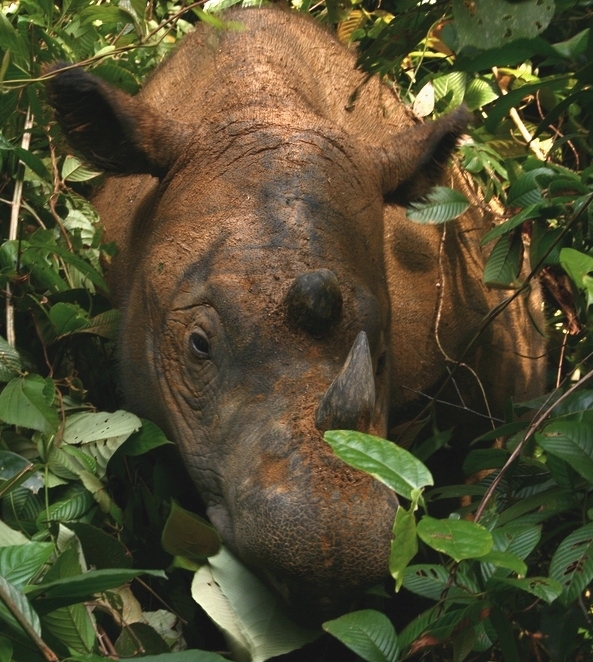
The last male Sumatran rhino has died.
Tam, the 30 something-year-old Sumatran rhino, died on Monday, May 27 at the Tabin Wildlife Reserve in Sabah, Malaysia. The death of Tam represents that death of the last known male Sumatran rhino in the country. Such an occurrence is another nail in the coffin of the species. The future of the Sumatran rhino is now even more uncertain than it has been for the past 20 years.
Tam fell ill in late April 2019 and his decline was rapid. He breathed his last the night of the 27th and passed away at the reserve, where he had lived since he was captured in 2008. “Today we bid farewell to Tam, our last surviving male Sumatran rhino” WWF Malaysia posted on their Facebook profile Monday. “Our hearts are filled with sadness as we mourn not only the loss of wildlife but the loss of a species.” Now that Tam is gone, the only Sumatran rhino left in the reserve is a female named Iman.
The reason for Tam’s death is currently not known, but care workers suspect that liver and kidney failures were to blame. These failures were most likely caused by old age as the average life expectancy for a Sumatran rhino is about 35-40 years.
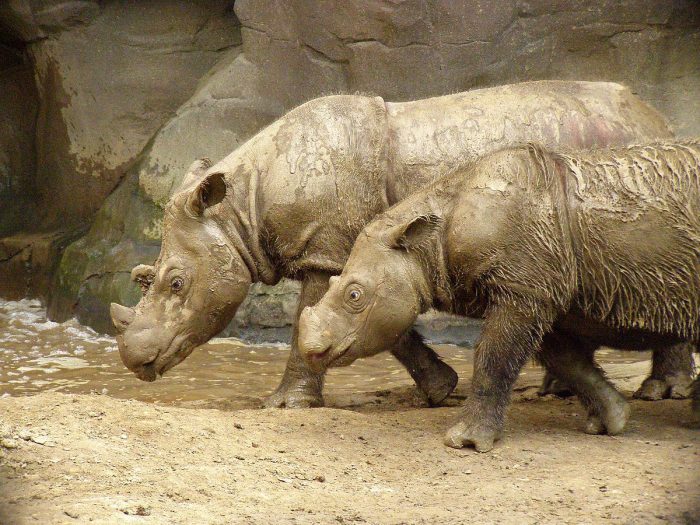
A pair of Sumatran rhinoceroses at the Cincinnati Zoo in 2008. Credit: “Sumatran rhino” by C. Hardin via WikiCommons CC-BY 2.0
The Sumatran rhino was declared extinct in the wild in 2015, but the presence of Tam was a thread of hope that the species could be rejuvenated. Unfortunately, all efforts to breed Tam using IVF with the other 2 female captives Puntung and Iman have failed. Puntung died in 2017 after contracting incurable cancer and now with the death of Tam, Iman is the lone surviving Sumatran rhino.
According to the WWF, the Sumatran rhino is critically endangered. While the species used to be widespread across Asia, deforestation and poaching have caused population numbers to dwindle rapidly in the past 40 years. It is estimated that only 80 individuals of the species are left in the wild, and even that estimate is a generous figure.
With the death of the last known male of the species, the future of the Sumatran rhino looks incredibly bleak. Remaining rhino populations are scattered across Kalimantan and Sumatra isolated from one another. Finding a viable mate is difficult because Sumatran rhinos tend to be solitary species unless mating and rearing calves. Sumatran rhinos do not flourish well in captivity and tend to develop fertility problems, which makes breeding captive specimens even more of a challenge.
There is still one last hope for the species. The lone female specimen Imam is still producing viable eggs, which means IVF could work. This possibility is slim though —according to Susie Ellis PH.D., the Executive Director for the Internation Rhino Foundation, “With limited knowledge about Sumatran rhino reproductive physiology, and the complexities of converting cells in the laboratory, these methods [IVF fertilization] were a long-shot, at best.”
History of the Sumatran Rhino
The Sumatran rhino in one of 5 extant species of rhinoceros and the only rhinoceros in the genus Dicerorhinus. It is the smallest known rhinoceros despite reaching heights of over 4 feet and weights over 1,000 pounds.
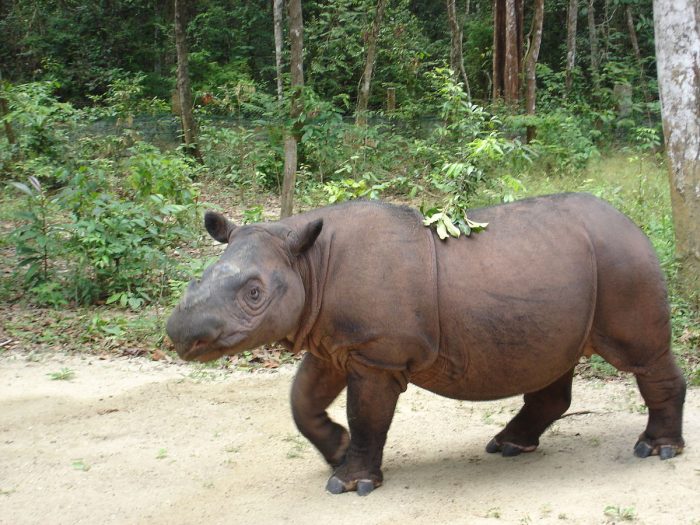
A 2013 photo of Ratu, a Sumatran rhino at a wildlife reserve in Lampung, Indonesia. Credit: “Sumatran Rhinoceros” by 26Isabella via WikiCommons CC BY-SA 3.0
Sumatran rhinos used to be widespread in rainforests, swamps, and temperate forests all throughout Southeastern Asia and their habitat extended to Eastern India and as far north as Burma.
The natural habitats of Sumatran rhinos are widespread which makes it hard for conservationists to protect them effectively. One of the biggest causes of Sumatran rhino population decline is poaching. Their horns are valuable on the black market and can sell for as much as $30,000 per kilogram. These horns are highly desired around Asia for their supposed aphrodisiac and medicinal properties.
Human poaching has rendered the species effectively extinct in certain regions. For example, in the 1980s, Kerinci Seblat National Park, the largest wildlife reserve in Sumatra, estimated their wild rhino population at over 500 individuals. Due to poaching, this population is now considered extinct and it is unlikely that any more living specimens exist in the Malaysian peninsula.
Sumatran rhinos are also heavily threatened by loss of habitat, particularly due to the palm oil industry in Southeast Asia. Indonesia and Malaysia produce more than 85% of the world’s palm oil and unsustainable farming greatly threatens numerous species in the region, including orangutans, Sumatran tigers, Sumatran elephants, and, of course, the Sumatran rhino.
In fact, the Sumatran rhino was declared extinct in the Indonesian region of Borneo in the 1990s. it was only in 2016 that a living Sumatran rhino was physically observed in the region, the first contact with the species in nearly 40 years.
Conservation Efforts
Despite public recognition and concerted efforts from conservation groups, movements to rehabilitate the Sumatran rhino have been largely unsuccessful. This is due to two main reasons: (1) Sumatran rhinos populations are sparse and they generally live alone. Their solitary lifestyle already makes it hard to find a mate, and the extremely low population numbers compound that difficulty. (2) Sumatran rhinos do not acclimate to captivity well. Living in captivity changes hormone levels in males and females, which decreases their fertility and often results in spontaneous abortions and stillbirths.
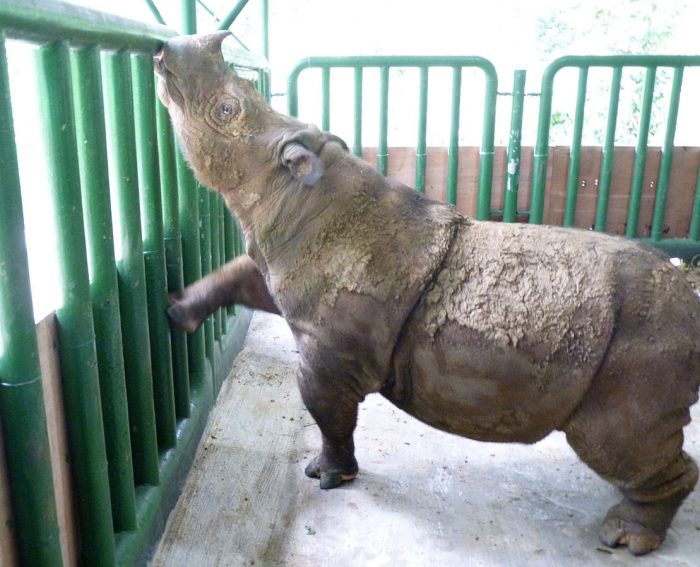
A photo of Ratu in labor. Credit: International Rhino Foundation via WikiCommons CC-BY 2.0
Most conservation efforts for the Sumatran rhino have been abject failures. A large scale captive breeding program from 1984 to 1996 saw the transfer of over 40 individual specimens to research facilities around the globe with the goal of breeding live specimens. By 1990, not a single rhino had been successfully bred in captivity. A 1997 report from the International Union for Conservation of Nature claimed that the program had failed “even maintaining the species within acceptable limits of mortality.”
The Bigger Picture
It is not only the Sumatran rhino either; virtually every species of rhinoceros in the world is either critically endangered or threated, largely for similar reasons. The Javan rhino, a close cousin to the Sumatran rhino, is near extinction, with an estimated 69 individuals left in the wild. Likewise, the African black rhino and the Nepalese greater one-horned rhino are severely threatened with populations estimated at 5,500 and 3,500 respectively.
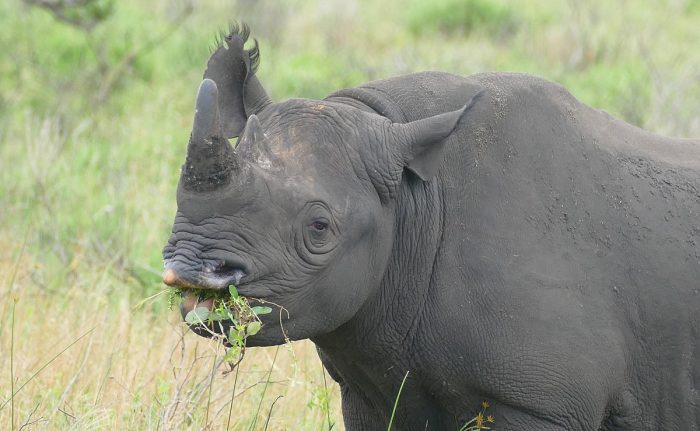
An African black rhino, another threatened species of rhinoceros. Credit: “Black rhino” by B. Dupont via WikiCommons CC BY-SA 2.0
The one success story for rhino conservationists is the South African White rhino. Population levels of the white rhino were estimated to be lower than 100 individuals in the early 1900s. Intense conservation efforts during the 20th century had a great deal of success and white rhino populations are now estimated to be between 17,000 and 19,000, with the majority of these individuals located in South Africa.
The story of the white rhino is a glimmer of hope for conservationists focused on the plight of the Sumatran rhino. One rhino population has already been brought back from the brink of extinction, so it is possible there is still a chance for the Sumatran rhino.
The Even Bigger Picture
The pending extinction of the Sumatran rhino illuminates a disturbing ecological trend. Since the emergence of humans roughly 195,000 years ago, the rate of species extinction has been roughly steady at about 1 to 5 species every year. Researchers estimate that now, extinction rates have climbed to over 1000 times the base rate, resulting in a loss of 1,000 individual species a year.
The single greatest factor influencing extinction rates is human activity. Over 99% of currently threatened species are threatened due to human activity, including habitat loss, unsustainable hunting and fishing, and ecological shifts caused by anthropogenic climate change.
Extinction rates have climbed so high that some scientists claim we are in the middle of the sixth great extinction event in Earth’s history, the last one being the K-T extinction event that killed off the dinosaurs and 3/4ths of all living species 65 million years ago. The main difference is that, unlike previous mass extinctions which had been caused by meteors, volcanic eruptions, and natural ecological shifts, the current crisis is being caused largely by human activity.
Adding to this stark picture of the ecological state on Earth, a UN-directed report released earlier this year found that over 1 million species are currently threatened or near threatened with extinction. The same report found that in the 20th century alone, species biodiversity has fallen by roughly 20% across the globe, indicating that nearly 1 in 4 species on average are threatened or will be threatened in the next few decades. A separate study published in April 2019 found that, given continuing trends, nearly 40% of insect species could be extinct in the next 3 decades.
No doubt these discoveries are harrowing, particularly in a political environment where the nation’s executive branch has taken active steps to roll back Obama-era environmental protections and curtail environmental research, particularly research surrounding climate change and its ecological effects.
There is no question that climate change (and ecological catastrophe in general) is the single greatest existential threat ever faced in human history. The way that we respond to this growing crisis will define who we are as a species and will set our course for the rest of the 21st century. If you want to get involved, the Union of Concerned Scientists (UCSUSA) has a list of resources on what you can do to help. At this point there are two choices: either humanity radically shifts its mode of political and economic organization to a more sustainable model, or we will watch the edifice of humanity slowly crumble as Nature rejects us; quoth the poet T.S. Elliot:
“This is the way the world ends
This is the way the world ends
Not with a bang, but with a whimper.”








